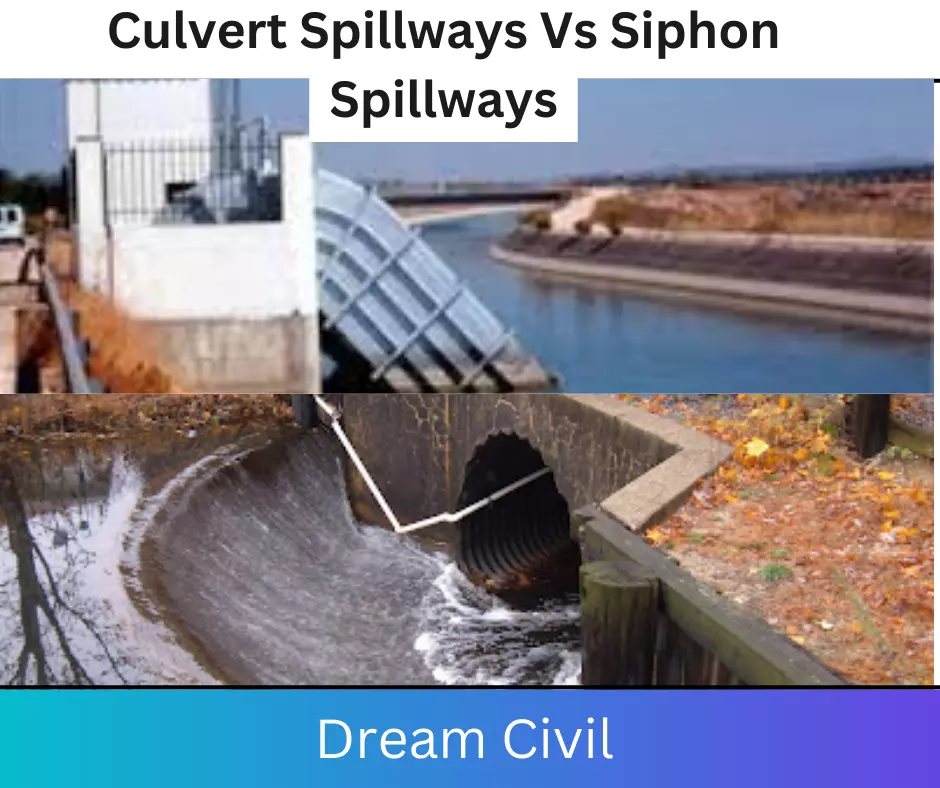Table of Contents
In this article, we will discuss Culvert spillways Vs Siphon spillways.
A. Culvert Spillways Vs Siphon Spillways
The difference between culvert spillways and siphon spillways are listed below:
1. Culvert Spillways
A culvert spillway is a special adaptation of the conduit or tunnel spillway.
It is distinguished from the drop inlet in that its inlet opening is placed either vertically or inclined upstream or downstream, and its profile grade is uniform or nearly uniform at any slope.
The spillway inlet opening may be sharp-edged or rounded, and the approach to the conduit may have flared or tapered sidewalls with a level or sloping floor. If it is desired that the conduit flow partly full for all conditions of discharge, special precautions should be taken to prevent the conduits from flowing full, if full flow is desired, bellmouth or streamlined inlet shapes are provided.
Culvert spillways operating with the inlet unsubmerged act similarly to an open channel spillway.
Those operating with the inlet submerged, but with the inlet orifice arranged so that full conduit flow is prevented, act similarly to an orifice-controlled drop inlet spiltway or to an orifice-controlled chute spillway.
Where priming action is induced and the conduit flows full, the operation will be similar to that of a siphon spillway.
When culvert spillways placed on steep slopes flow full, reduced or negative pressures prevail along the boundaries of the conduit. Large negative pressures may cause cavitation to the surfaces of the conduit or even its collapse. Where cracks or Joints occur along the low-pressure regions, there is also the possibility of drawing in the soil surrounding the conduit.
Culvert spillways, therefore, should not be used for high-head installations where large negative pressures can develop. Furthermore, the transition flow phenomenon, when the flow changes from part ‘ow to full stage, is accompanied by severe pulsations and vibrations that increase in magnitude with increased culvert fall. For these reasons, culvert spillways should not be used for hydraulic drops exceeding 25 feet.
For drops less than 25 feet, culvert spillways offer advantages over similar types because of their adaptability for either partial flow or full flow operation and because of their simplicity and economy of construction.
They can be placed on a bench excavated along the abutment on a remove steep sidehill or they can be placed through the main section of the dam to discharge directly into the downstream river channel.
As is the case with a drop inlet, a principal disadvantage of the culvert spillway is that it does not provide a safety factor against underestimation of the design flood because its capacity does not substantially increase with the increase in the head. This disadvantage would not apply if the culvert spillway were used as a service spillway in conjunction auxiliary or emergency spillway.

2. Siphon Spillway
If the available space is limited and discharge isn’t large, siphon spillway is often superior to other forms. It is based on the siphonic action in the shape of an inverted pipe The spillway must be vented properly to maintain the water level within normal water level. Without air vent provision, once the siphonic action started, the upstream water is drawn down to the level of the entrance before flow cases (rather than the normal water level).
The working principle of the siphon spillway shall be as follows:
1. When the water starts to rise in the reservoir above the NWL then water starts to spill from the siphon spillway.
2. When the water rises just above the depriming hood, the duct of the siphon is locked by the water from both ends.
3. In order to increase the rate of priming of the siphon spillway, a baby priming arrangement is made.
4. The flowing water from the crest of the spillway will suck the entrapped air inside the duct.
5. This will cause a gradual increase in the vacuum pressure (sucking pressure) inside the duct.
6. The negative pressure will suck more water from the reservoir and finally, the duct will be running full of water.
7. The siphon is in full operation now.
8. The time period between the instant that the water just starts to spill from the crest to the instance that the siphon runs in full are called the priming.

Hope you like our article Culvert Spillways Vs Siphon Spillways.
Read Also: Culverts

